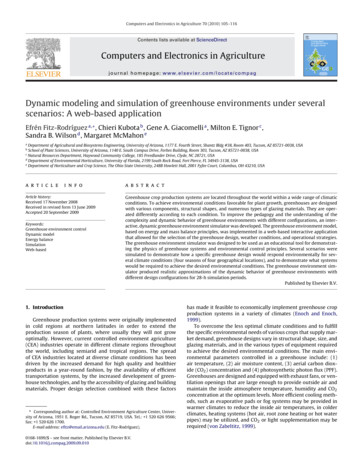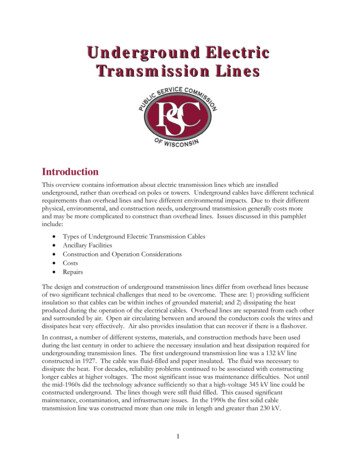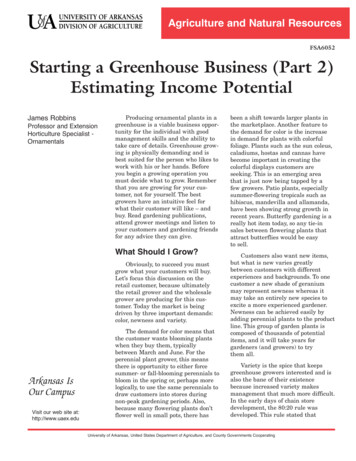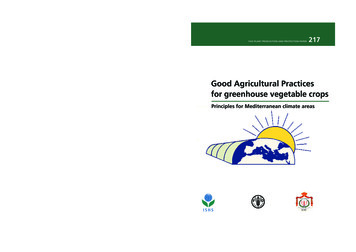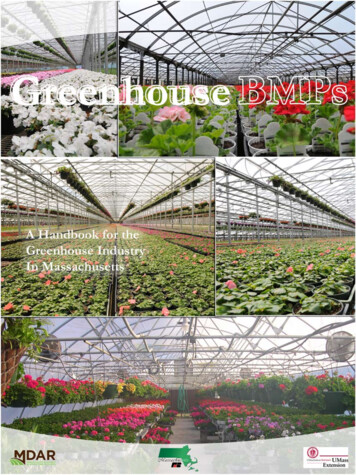
Transcription
Walipini Construction (The Underground Greenhouse)Revised Version-2002Benson Agriculture and Food InstituteBrigham Young UniversityB-49 Provo, Utah 84602
Table of ContentsPageIntroduction . 1I. How the Walipini works . 1Earth’s Natural Heat -- Why dig in? . 2More Free Energy -- The Sun . 3Heat Storage -- Mass/Flywheel . 3Cutting Heat Loss – Insulation . 4II. Location of the Walipini. 4The Danger of Water Penetration . 4Digging into the Hillside . 5Maximizing the Sun’s Energy . 5Alignment to the Winter Sun . 6Angle of the Roof to the Sun . 6Azimuth . 8Obstructions . 9III. Walipini Design . 9Size and Cost Considerations . 9Venting Systems . 10Method 1 . 11Method 2 . 12Method 3 . 12-i-
Method 4 . 13Interior Drainage System . 13Exterior Drainage System. 14Water Collection Drainage/Heating SystemIV. Building the WalipiniTool List. 16. 16Materials List. 17Laying Out the BuildingThe ExcavationThe Walls. 15. 17. 18. 20Roof and Glazing. 21Berms & Exterior DrainageVenting Systems. 23. 24Completion and Charging. 24-ii-
Introduction: The Walipini (underground or pit greenhouse) in this bulletin is designedspecifically for the area of La Paz, Bolivia. However, the principles explained in the bulletinmake it possible to build the Walipini in a wide variety of other geographic and climaticconditions. The word ‟Walipini” comes from the Aymara Indian language of this area of theworld and means ‟place of warmth”. The Walipini utilizes nature’s resources to provide awarm, stable, well-lit environment for year-round vegetable production. Locating the growingarea 6’- 8’ undergroundand capturing and storing daytime solar radiation are the mostimportant principles in building a successful Walipini.I. How the Walipini WorksThe Walipini, in simplest terms, is a rectangular hole in the ground 6 ‛ to 8’ deep covered byplastic sheeting. The longest area of the rectangle faces the winter sun -- to the north in theSouthern Hemisphere and to the south in the Northern Hemisphere. A thick wall of rammedearth at the back of the building and a much lower wall at the front provide the needed angle forthe plastic sheet roof. This roof seals the hole, provides an insulating airspace between the twolayers of plastic (a sheet on the top and another on the bottom of the roof/poles) and allows thesuns rays to penetrate creating a warm, stable environment for plant growth.-1-
The Earth’s Natural Heat -- Why dig in?The earth’s center is a molten core of magma which heats the entire sphere. At approximately4’ from the surface this heating process becomes apparent as the temperature on most of theplanet at 4’ deep stays between 50 and 60º F. When the temperature above ground is cold, say10º F with a cold wind, the soil temperature at 4’ deep in the earth will be at least fifty degrees inmost places. By digging the Walipini into the ground, the tremendous flywheel of stabletemperature called the ‟thermal constant” is tapped. Thus, the additional heat needed from thesun’s rays as they pass through the plastic and provide interior heat is much less in the Walipinithan in the above ground greenhouse. Example: An underground temperature of 50º requiresheating the Walipini’s interior only 30º to reach an ambient temperature of 80º. An aboveground temperature of 10º requires heating a greenhouse 70º for an ambient temperature of 80º.-2-
More Free Energy -- The SunEnergy and light from the sun enter the Walipini through the plastic covered roof and arereflected and absorbed throughout the underground structure. By using translucent material,plastic instead of glass, plant growth is improved as certain rays of the light spectrum that inhibitplant growth are filtered out. The sun’s rays provide both heat and light needed by plants. Heatis not only immediately provided as the light enters and heats the air, but heat is also stored asthe mass of the entire building absorbs heat from the sun’s rays.Heat Storage -- Mass and the Flywheel EffectAs mass, (earth, stone, water -- dense matter) comes in contact with sunlight, it absorbs andstores heat. The more dense the mass (water is more dense than rock and rock is more densethan soil) the more energy can be stored in a given area. Mass of a darker color such as flatbrown, green or black absorbs heat best. Light colors, such as white, reflect heat best. As theearthen walls of the Walipini absorb this heat they charge with heat much like a battery chargeswith electricity. This storing of the heat in the mass of the soil is often referred to as the‟flywheel effect”, with the flywheel being charged in the day (storing heat/energy) and spinningdown or discharging at night as heat/energy flows from the earthen walls out of the greenhouseup through the plastic glazing to the colder night air. The amount of heat stored in the mass is acritical factor in keeping crops from being frost bitten or frozen during the coldest nights of thewinter. These critical nights are usually encountered around the time of the winter equinox (June21 in the Southern Hemisphere and December 21 in the Northern Hemisphere). The Walipini isusually designed to absorb more of the sun’s rays/heat during the three coldest months of thewinter than during any other time of the year. The key here is to have enough energy stored inthe mass so that on the coldest nights, the plants are not damaged. In general, nighttimetemperatures should not be allowed to drop below 45º. This minimum temperature is alsodependent upon the types of crops being grown, as some are hardier than others and may requirecolder nighttime temperatures. An easy way to increase the mass is to put a few 55 gallondrums filled with water and painted flat black along the back wall of the Walipini. Somegrowing space will be lost, but the heated water will greatly enhance mass heat/energy storageand will provide preheated water for plant irrigation. Preheated water reduces plant shock, thus,-3-
assisting plant growth.Cutting Down Heat Loss -- InsulationA double layer of plastic sheeting (glazing) should be used on the roof. This provides a form ofinsulation and slows down the escaping of heat during the nighttime. This sealed dead-air spacebetween the plastic sheeting should be between 3/4” to 4” thick. Poles used to span the roof thatare 3.5” to 4” in diameter provide the indicated thickness of dead air space when plastic sheetingis affixed to the outside and the inside of the roof’s structure. The inside sheeting also keeps theinside humidity from penetrating and rotting the wooden poles spanning the roof.All above-ground walls should be bermed with as much soil as possible. This provides someextra mass, but provides much more insulation against above-ground cold temperature, windsand moisture penetration.When nighttime temperatures are continuously well below freezing, insulated shutters madefrom foam insulation board or canvas sheets filled with straw or grass can be placed over theglazing. This requires more work and storage, and in many environments is unnecessary, suchas is the case in the area of La Paz, Bolivia.II. Location of the Walipini:The Danger of Water PenetrationWater penetration of the walls and/or floor of the Walipini is destructive. If water seeps throughthe walls, they will collapse. If water comes up through the floor, it will adversely affect plantgrowth and promote plant disease. Dig the Walipini in an area where its bottom is at least 5’above the water table. When all of the above ground walls are bermed, a layer of water-proofclay, such as bentonite, or plastic sheeting, should be buried approximately 6” to 1’ under theberm surface. It should be slanted so that the water drains away from the Walipini to thedrainage ditches. In some cases where the soil has a low permeability rate, the clay or plasticmay not be necessary. Be sure to dig a shallow drainage ditch around the perimeter of theWalipini which leads run off water well away from the structure.-4-
Digging into the HillsideWalipinis can be dug into a hillside providing the soil is stable and not under downwardpressure. Since the Walipini has no footing or foundation, a wall in unstable soil or underpressure will eventually collapse.Maximizing the Sun’s EnergyThesun isorbited by the earth once a year in an elliptical (oval) path at an average distance of 93M miles.The earth spins on its own axis creating the rising and setting of the sun. The earth is tilted at 231/2º from the plane of its solar orbit, which is why the sun appears lower in the sky in the winterand higher in the sky in the summer.These variables in movement make the location of the sun, both in height and plane, differenteach and every day of the year. However, since the daily difference is minimal, the Walipini canbe located to maximize heat in any given season. For vegetable production, this maximizedlocation is for winter heating of its interior as this will be the most crucial time of the year forplant survival.Alignment of the Walipini to the Winter Sun-5-
Since the sun will come up in the East and go down in the West, the length of the rectangularWalipini will stretch from east to west with the tilt angle of the roof facing north towards thewinter sun in the Southern Hemisphere or towards the south in the Northern Hemisphere.This allowsthe largestmass, the inside back (the highest) wall, to be exposed to the sun the longest as the sun movesacross the horizon. Some adjustments can be made for local conditions. If winter conditionsfrequently produce hazy or cloudy mornings or high mountains in the east make for a latesunrise, it may be best to locate the Walipini 10-15º to the north west of true east in order keepthe afternoon sun in the Walipini for a longer period of time. If winter mornings are generallyclear, it can be located at 10 to 15 º north east of true east to maximize the early morning rays fora longer period. Maximum heating will usually take place between 10:00 a.m. and 3:00 p.m.Angle of the Roof to the SunIn order to make the simple calculation for the best angle of the roof (the plastic glazing) formaximum sun penetration at the winter solstice (the shortest day of the year), use the followingrule of thumb: 1) Obtain a good map and determine the latitude on the globe. La Paz is locatedat 16.4º south of the equator.2) Add approximately 23º which will make a tilt angle of 39 - 40º for the La Paz area. This will-6-
set the glazing of the roof perpendicular to the sun on the winter solstice, which will maximizesun penetration and minimize reflection.At the summersolstice thisangle will have the opposite effect and maximize reflection and minimize penetration.This anglecan bevaried, but will change the basic design of maximizing heat during a winter solstice andminimizing it during the summer solstice.Azimuth-7-
The change in the length of daylight from summer to winter is the result of the azimuth. The sunis higher in the sky in the summer and also goes through a much wider plan arc, orazimuth, thus making the days longer.At 16.4º south latitude, in (La Paz) the summer azimuth is approximately 340º while the winterazimuth angle is about 170º. This means that the winter sun rises at 85º east of north and sets at85º west of north. Since we are seeking maximum heating in the Walipini on the winter solstice(June 21 in the Southern Hemisphere and Dec 21), the orientation of the Walipini and the angleof its glazing are designed to facilitate maximum sun penetration at the winter solstice.-8-
ObstructionsMake sure that the Walipini is located so that its face (the roof angle facing the sun) has noobstructions such as trees, other buildings, etc. which will obstruct the sun. This is also true ofthe east and west sides of the structure. The only exception to this rule would be a fewdeciduous trees which lose their leaves in the winter. They can provide limited shading in thehot summer, but little shade in the winter.III. Walipini DesignSize and Cost ConsiderationsThe primary considerations in designing the Walipini are cost and year-round food productionfor the family. The minimum recommended size is 8’ x 12’. However, generally speaking, thelarger the Walipini, the more cost effective per square foot the construction will be. A minimumof 94 sq. ft. of growing space per person is recommended for a year-round vegetable supply.Thus, for a family of seven people a 12’ x 66’ area 792 sq. ft. Less 16% for access 665 sq.ft. of growing space divided by 7 people 94 sq. ft. per person in the La Paz model. Keeping-9-
the size of the Walipini manageable and its cost as low as possible are important designconsiderations.The Walipini is designed to keep costs as low as possible using the following: 1) Free labor -the builder’s and that of friend’s and neighbor’s; 2) Only unlined, inclined, interior earthenwalls; 3) Traditional concrete footings and foundations are excluded because they areunnecessary, when the perimeter of the building is protected from water penetration; 4) Plasticultraviolet (UV) protective sheeting on the top and underside of the roof instead of glass orcorrugated fiberglass panels; 5) The most economical, durable materials found thus far forspanning the roof are 4” eucalyptus poles or PVC pipe; 6) The top soil from the dig is used atthe bottom for the planting soil; 7) The rest of the soil from the dig is used for the rammed earthwalls, berms and adobes; 8) Stones and any gravel from the dig are used in the planting areadrainage system and sump-wells; and 9) Used materials are utilized where possible and practicalsuch as used, cleaned 55 gallon oil drums, used doors, etc. It is assumed that only some of thematerials will have a monetary cost and that labor will have none. The cost of materials willvary from location to location and will also vary according to what is available free of cost.Materials for the current La Paz models (20’ x 74’) are 250 to 300.Venting SystemVenting can become a crucial factor in controlling overheating and too much humidity in theWalipini. Too much venting can also be a detriment and, thus, the proper balance must be-10-
maintained for optimum plant growth. This balance is dependent upon a combination of thefactors discussed in the previous three sections. Four methods of venting the Walipini will bediscussed in ascending order of volume of air ventilation possible in each system. Each methodhas its advantages and disadvantages regarding labor, mass storage, cost, volume of air flow,etc.: 1) The first method, currently used in the La Paz model, is that of ventilating by using twodoors at opposite ends of the building. It requires no additional vents, material, or labor, but itlacks the advantage of low to high convection ventilation which can move much greater volumesof air sometimes needed, if temperature and humidity climb too high.Venting Method # 12) Method two uses the same doors with the addition of a vent of equal size as one of the doorswhen the vent is fully opened. This vent is centered at top of the back wall. It requires lessrammed earth (labor) in the back wall (the vent area) and it provides a much greater volume ofair exchange when needed. However, heat storage mass is lost in the back wall where most ofthe heat is collected, more interior surface area is exposed to the outside cold, a lintel must spanthe vent to support the roof poles and additional labor is required to contour and seal the berm atthe vent on the exterior back wall.-11-
VentingMethod # 23) Method three uses the same doors with an additional trap door type vent of equal size in theroof.Venting Method # 3-12-
This vent is located in the roof at the center, back against the rear wall at the highest point.When needed, thehighest volumeof air exchange,thus far, can beobtained and noheat-storage massis lost in the backwall. However,if the operablevent in the roof isnot builtcorrectly, evenwhen in theclosed position, itwill leak rainwater and willallow heated airto filter out whenit is most needed.Only a fewboards for theframe and twohinges are neededto build this 4’ x4’ vent.4) Method four uses the same doors in conjunction with the addition of a chimney located at thebottom center of the rear wall.Venting Method # 4-13-
This system provides the highest volume and best control of ventilation while retaining mass, butit requires more labor, a little more material in the adobes, 4 short vertical poles and a rainshield.Interior Drainage SystemKeeping moisture from building up to such a degree that it adversely affects plant growth andcontributes to plant disease is an important aspect of the interior drainage system.As the hole for the Walipini is dug, it is excavated to an approximate depth of 1 - 2’ deeper thanit will be when in operation. This area (1 - 2’ of depth) is filled with stone, gravel and 8” of topsoil. The larger stones are placed at the bottom with the gravel becoming progressively smalleras it meets the layer of top soil. The bottom of the dig will be progressively sloped from thecenter to the ends with a drop of 1/4” per foot. In the La Paz model this means that from thecenter, the bottom of the dig to each end will have an over-all drop of 8.25” (The center to eachend is 33’ x .25 8.25”.). This incline will allow excess water to flow to each end of thebuilding. At each end of the building a 2’ x 3’ gravel-filled sump/well deep enough to absorbthe runoff is found. The top of this sump should be covered with an openable lid so that watercan be removed with a bucket when and if needed. Moisture content inside of the Walipini canalso be controlled by the amount and frequency of irrigation, and by venting.-14-
Exterior DrainageWater is both friend and foe of the Walipini growing system and must be handled appropriately.Exterior drainage of excess rainfall away from the Walipini is crucial.For thisreason bermsmust havesufficientincline awayfrom theundergroundwalls of thebuilding tomove wateraway quickly.A minimumof a quarterinch drop perrunning footisrecommended.Depending upon the porosity of the soil, it may be necessary to bury a layer of clay such as-15-
bentonite or a layer of plastic sheeting from the rammed earth wall to the perimeter drainageditch.How far the ditch is away from the interior wall of the building will depend upon how effectivelyone can seal the berms and/or move the water away from the building. Most currently-existingWalipinis which have had no wall moisture penetration have an average berm length on the high,back wall of about 10’, on the front low wall of about 5’ and on the side walls also about 5’.These Walipinis are located in heavy clay soil which helps to inhibit water penetration.Water Collection Heating/Irrigation SystemThis system collects runoff from the roof at the front of the roof in a galvanized metal or PVCrain gutter. From the gutter water flows through a pipe into the 55-gallon barrel/drum systemused for irrigation and mass heat storage.-16-
Each of the barrels is connected by overflow piping at the top with the overflow pipe at the lastbarrel exiting at ground level under the back berm to the perimeter drainage ditch.In case of a down-pour or continuous excessive rain, it would be wise to have a T pipe/valve atthe bottom of the gutter so that the runoff can be diverted to an outside perimeter ditch instead ofmoving down to the already full barrel system. How much run off the system can handle in agiven period of time will depend upon the size of the gutter and the diameter of the pipe used.The larger the diameter, the more volume of water can be handled. As previously indicated, thissystem provides not only preheated irrigation water, but a dense solar mass (water) in whichadditional heat is stored for the cold winter nights.IV. Building the WalipiniTool ListHammers, shovels, picks, saws, wheelbarrows, crowbar, forms for rammed earth compaction(two 2 ‟ x 12” x 6’ planks held together by 2” x 4” or metal rods or many other type of formscan be made), 100’ and 25’ measuring tapes ( If 100’ tape is not available, measure out and mark100’ of string or rope), levels, clear hose for corner leveling, cutting knives, hose, nozzle, handcompactors, adobe forms, drill, bits, stakes, nylon string, etc.-17-
Materials List for a 20' x 74' WalipiniWater20 -- 4” x 16’ poles or PVC pipes to span the roof3 -- 3’ x 6’ hinged doors (one is for the 3’ x 5’ vent cover)3 -- 3’ x 5’ door frames ( 2 if rear wall vent is not used)2 -- 3’ x 6’ door lintels1 -- 6’ x 3’ vent lintel or roof frame for vent, if used1700 sq.’ of 200 micron agrofilm (polyethylene UV plastic)640’ of 1” wood stripping to secure plastic sheeting to the polesShovels, tractor or ox drawn fresno plow to dig hole30 cubic. yds. of gravel for the floor drainage system1 cubic yds of gravel or stone to fill the 2 drain sumps233 cubic yds of soil will come from the excavation22 cubic yds of top soil for planting (8” x 66’ x 12’)94 cubic yds. for the rammed earth wallsThis will leave a remainder of 109 cubic yds. for wall berms.2700 sq’ of plastic sheeting to bury for drainage, if needed74 ‛ of drain gutter for the lower end of roof100’ of overthrow/drain pipe from gutter through barrel system to perimeter drainage ditchNails116 8” x 4” x 12” adobes for the perimeter to seal plastic roof edgeLaying out the BuildingWe will use the La Paz model. Select the site location as explained in section I and measure outthe 12.5’ x 66’ growing area marking it by driving stakes and stretching string. Now ‟square”the area using the tape or the pre-marked rope. Next go along the string line and mark theoutline of the area to be dug with lime. Set the batter boards and grade stakes using the clearhose level or a transit making sure they are all set at the same level. They are used to measurefor uniform depth of the hole and for uniform level the ground upon which the walls will berammed. If one or more walls are going to be rammed as the soil is removed, also lay out and-18-
mark them.The Excavation -- Digging the HoleThe hole should be dug 1’ - 2’ deeper than the growing surface. This allows room forrock/gravel fill and then the top soil. Separate the first 8” of top soil from the rest of the soil asit will be used as the top soil for growing in the Walipini. The excavation can be hand-dugwhich is made easier by wetting the area first, by an ox or horse-drawn fresno plow/scraper usedby the pioneers in the USA to dig canals, basements, earthen tanks, etc. or by machine (tractor orbackhoe). The method used will depend primarily upon the availability of time and money.As the soil is removed, remember to pile the soil in areas where it will be used for berming andthe rammed walls. Moving it the least number of times will reduce labor. (Some of the rammedearth walls can be built at the same time the excavation is going on using the soil as it comesfrom the hole). Soil for rammed earth should contain approximately 10% moisture – just moistenough to hold its shape after being compresses in your hand.Don’t forget to dig the two channels needed for the door entrances at opposite ends of thebuilding. It is important to note that all four vertical walls of the dig need to be sloped from thebottom to the outside at the top. A minimum of a 6” slope from bottom to top is suggested for a6’ high wall. This will greatly reduce soil caving in or crumbling off from the walls over time.-19-
The floor should be sloped for interior drainage from the center to each end and sump/wells dugat each end before starting to back-fill with gravel and topsoil as explained in the previoussection. Next place the stones, then gravel at the bottom of the Walipini and in the sumps. Mixthe top soil with organic matter and the appropriate fertilizer, as needed, and spread the top soilat least 8” thick over the gravel drainage system.The door jams (frames) and doors should now be installed at the bottom level of the two rampsat the level of the growing surface. Door jams (frames) should be of 2” thick board stock, suchas 2” x 8”s, with holes drilled at the top, middle and bottom of each side. Wooden stakes,dowels, or rebar are then driven through these six holes into the earthen wall in each jam to setthe doors in plum vertical position (use a level).Install the doors making sure they fit as airtight as possible.Fill in any air cracks found around the door frames with adobe mud (clay, sand and straw mix).This completes the underground portion of the Walipini.-20-
The WallsLay out the walls all the way around by dropping back 6” from the edge of the excavation.Using the grade stakes as the reference, make sure the soil foundation for the walls is level anduniform all the way around the building. Mark the layout of the walls with lime and beginramming them staring at a corner using the ramming form. Mix the soil to approximately 10%moisture content before shoveling it into the form. A good rule of thumb for the 10% moisturecontent is -- 1) If the soil holds its shape after being tightly-squeezed in the hand and 2) When itis dropped to the ground, if it cracks and crumbles somewhat instead of splatting into a plasticmass, the moisture content is about right. If it splats like a mud ball, it is too wet. Beforestarting to ram the soil into the form, wet (not soak to a muddy texture) the soil area at thebottom of the form for a better bond between the two surfaces. Start ramming earth into theform beginning at one of the corners. When the doors are reached, pin (using rebar stakes) alintel (metal or wood) over each door to support the weight of the wall to be built on top of it.The lintel must be as wide as the wall (18” to 3’), a foot longer on each side than the width of thedoor (5’ for the 3.0 door) and approximately 4” thick, if using wood. (The 4” poles used to span-21-
the roof, cut in to 5’ lengths laid side by side and wired and/or nailed together on top of the doorframe may be sufficient. Continue moving the form and ramming the first course/level of earthuntil the first level is completed all the way around the building. As the form is set for the nextcourses as the wall goes up, always check with a level to make sure that the walls are straight upand down (perpendicular to the ground) and not leaning to one side or the other.Begin the second course of rammed earth on top of the first at the mid-point of the first form thatwas rammed. This will cause the vertical joints of each form length to be staggered and greatlyincrease the strength of the wall.Be sure to wet the exposed surface of the soil at the bottom of the form each time beforebeginning to ram. This will increase the adhesion of the h
Introduction: The Walipini (underground or pit greenhouse) in this bulletin is designed specifically for the area of La Paz, Bolivia. However, the principles explained in the bulletin make it possible to build the Walipini in a


